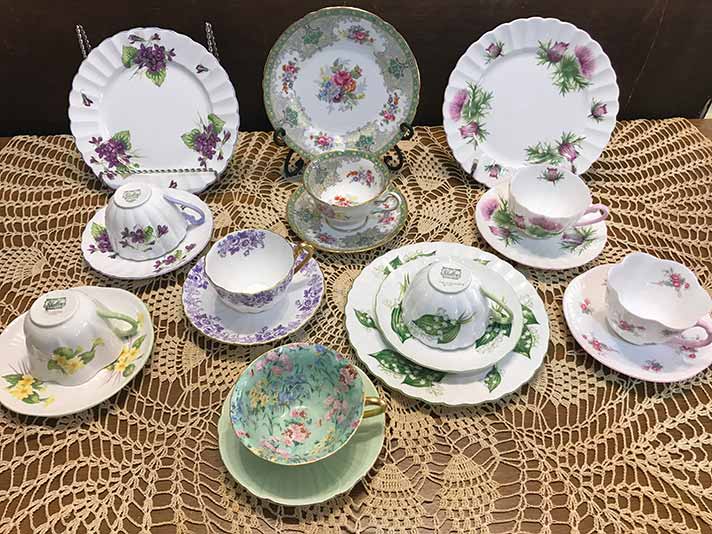Speaking of Antiquing – November 2020
Shelley Bone China is simply lovely and was made to be used… and used often. Its mixture has a high concentration of beef bone with clay and stone to make it delicate and strong. Shelley is beautiful to look at and pleasant to the touch. Detailed artists spent many hours creating designs from floral to geometrics to art deco, created from lithographs and applied meticulously to the product. Each item went through several firing processes, polishing, and quality control that few factories employed. It is no wonder that after 100 years plus, Shelley china has endured and is loved and collected by generations.
Collectors love the hundreds of patterns and many shapes. A single cup design can come in various sizes, the largest being the farmer’s cup, aka “Grandfather’s cup.” There’s the tea size and the coffee size, or demitasse, and even a miniature size.
The shapes have different names also. The Dainty shape is probably the one most Americans are familiar with and was manufactured between 1896 and 1966. There is a footed Dainty, Dainty Tea and Dainty Coffee, each with different sized saucers. The Oleander pattern has a Tea, Tall and Footed; each different from the other but with the same beautiful transferware.
Every piece is stamped under the glaze, marked and numbered and can be referenced using the original lists. The Shelley manufacturing Co., in Staffordshire England, took great care to catalogue and detail each shape and pattern.
Collectors could spend a lifetime collecting teapots in the different styles and sizes as well as the multitude of miniatures. Many of them are rare and quite expensive. During WWII, English china manufactures were only allowed to produce decorated wares for export. The white ware is highly sought after. It was simple and strong. Many of that generation are quite sentimental for it… for the sacrifices they endured.
Before the company took the name Shelley in 1925, it was Wileman & Co., that began in 1860 in the Staffordshire region of England where it used the name Foley for one of their factories. Henry Wileman hired Joseph Shelley as a salesman and he eventually took control of the company with his sons, naming it Shelley. Percy Shelley ran the company for over 50 years.
The Shelley Company ceased operation in 1966, as they could not keep up with the less expensive, mass-produced pottery on the market. The firm was purchased by Allied who continued to sell Shelley until the supply ran out.
Due to its collectability, Shelley is an item that doesn’t remain in the shop long, so come by Pickety Place and see what we have. We are open every day.

 Margaret Barns is co-owner of Pickety Place Antiques & Collectibles located at 130 N. 4th Street in Jacksonville. LIKE them on
Margaret Barns is co-owner of Pickety Place Antiques & Collectibles located at 130 N. 4th Street in Jacksonville. LIKE them on
Do you buy pieces. I have mini creamer and sugar bowl for Blossom Pattern.
Hi Debra:
We sent your info on to Margaret Barnes so she can let you know.
Or call Pickety Place at 541-899-1912.
Thank you!